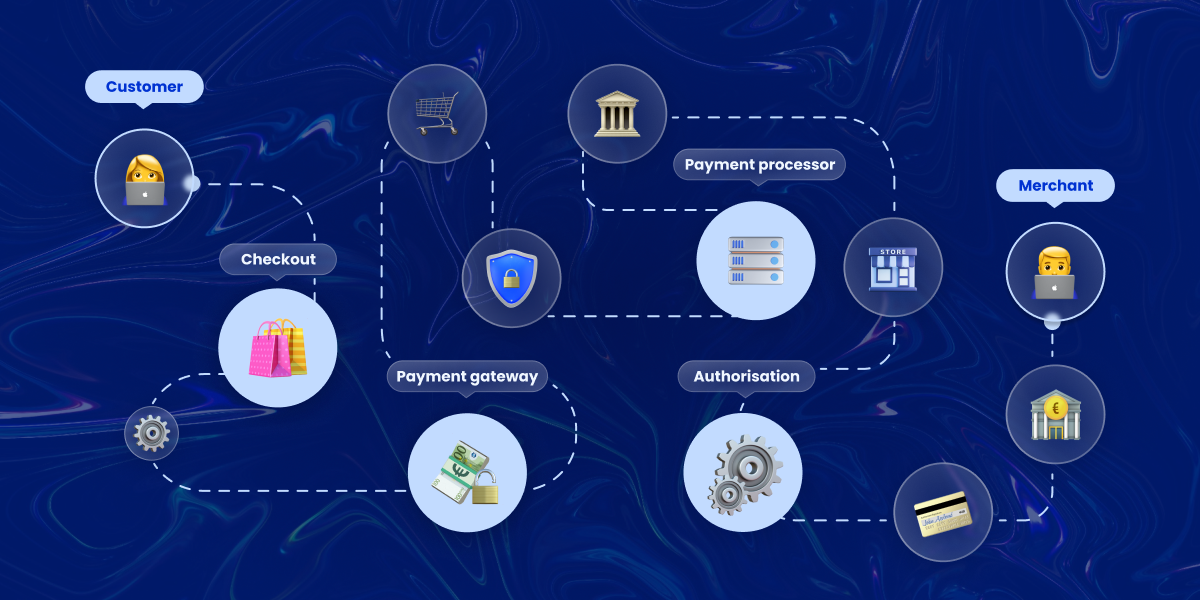E-commerce payment processing: What to consider?
The world of e-commerce thrives on convenience and trust. While browsing product pages and adding items to carts might seem effortless, a complex ecosystem powers the transaction behind every “buy now” click. And it’s not just about providing a technical process.
When it comes to securing a sale, the checkout experience is paramount. A smooth and secure payment process can be just what stands between a loyal customer and an abandoned shopping cart. So, let’s delve into the intricacies of payment processing in the e-commerce world and see how it can bring success to your business.
The e-commerce payment processing flow
E-commerce payment processing is a system that provides secure online transaction handling for purchasing goods and services. It includes authorising payments, preventing fraud, and ensuring that funds are transferred from customers to merchants. Payment processing involves several parties and has a clearly regulated procedure:

- Checkout: At checkout, the customer enters their payment information, such as credit card details or login credentials for a digital wallet.
- Payment gateway: The information is sent to a payment gateway, a secure portal that acts as an intermediary between the customer and the merchant’s payment processor. The gateway doesn’t store sensitive data; it simply encrypts and transmits the information for authorisation.
- Payment processor: The payment processor receives the encrypted information and verifies it with the customer’s bank or financial institution. This verification process ensures the availability of sufficient funds and checks for potential fraud.
- Authorisation: If everything is confirmed, the bank authorises the transaction and sends approval back to the payment processor.
- Settlement: The payment processor then sends the authorisation to the merchant’s bank account. However, the funds aren’t immediately credited to the merchant account. Depending on the payment method, it might take a few days delay before the funds settle.
- Confirmation: The merchant receives confirmation of the successful transaction and can fulfil the customer’s order. The customer also receives confirmation that their payment has been processed.
Priorities for an efficient e-commerce payment experience
Now that we understand the flow let’s explore the key priorities for e-commerce businesses when it comes to payment processing:
- Offering a diverse choice of payment methods: Customers today expect various payment options. This includes credit cards, debit cards, digital wallets, and potentially even regional favourites like WeChat Pay or Alipay. So, it’s important to cater to your target audience’s preferences to avoid cart abandonment due to limited payment options.
- Security and fraud prevention: Security breaches can be devastating, undermining customer trust and damaging your reputation. Make sure that your payment partners comply with PCI DSS and implement robust fraud detection tools and tokenization to safeguard sensitive information and prevent fraudulent transactions.
- Frictionless checkout: A smooth and user-friendly checkout process is crucial. The right course of action here will be offering one-click checkout for returning customers, allowing guest checkout for faster purchases, and ensuring clear communication of all available payment options, shipping costs, and taxes upfront. Together with good mobile optimisation and clear design, this can increase your conversion rate by 35%.
- Managing processing fees: Transaction fees can significantly impact your profit margins, and payment processors often impose hidden additional fees. However it’s not the case with Payop. With us, you pay only for successful transactions. No account maintenance charges or other hidden commissions.
- Staying ahead of the curve: The payment landscape is constantly evolving. Keep an eye on open banking technology, revolutionising the financial industry and how we envision payments. Payop is implementing this innovation to offer our merchants Pay-by-Bank – secure direct bank account payments.
Top Payment Methods for the E-commerce Industry
To meet a diverse customer base and optimise your payment processing strategy, here are the top payment methods to consider for your e-commerce business:
- Credit and debit cards: These remain the most popular payment methods globally, with Visa, and Mastercard being the leading networks. Ensure your platform supports these major players.
- Digital wallets: Offering e-wallets like PayDo provides a convenient and secure one-click checkout experience for customers with these services linked to their smartphones.
- Alternative Payment Methods: Depending on your target market, consider integrating popular regional options like WeChat Pay in Asia, Pix in Latin America or “Buy Now, Pay Later” (BNPL) services that cater to budget-conscious consumers.
By prioritising these key areas and offering a diverse mix of secure and convenient payment options, you can create a robust payment processing system that fosters customer trust, optimises the checkout experience, and ultimately drives sales success.
Payop can be your reliable partner on this path, taking care of your transactions and allowing you to concentrate on different aspects of your business. Contact us at [email protected] to get an individual consultation.